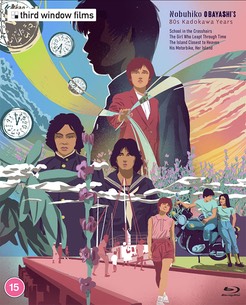
Ever since the director Obayashi Nobuhiko visited Yale in 2015, I’ve been significantly engaged with his cinema in one form or another, from curating a Japan Society retro to starting a book project (which occasioned an Obayashi workshop earlier this fall). This has recently extended to helping out with Blu-ray releases. Adam Torel of Third Window Films asked me last year to pen a piece for the booklet accompanying his release of Obayashi’s Anti-War Trilogy, and then this year asked for help with his release of four Obayashi films from the director's years working with Kadokawa Film. That has now come out in a box set titled Nobuhiko Obayashi’s 80s Kadokawa Years.
There is still relatively little written about Kadokawa in English (Alex Zahlten’s The End of Japanese Cinema is one significant exception), even though the films produced by Kadokawa Haruki—as well as his industrial strategy—helped define Japanese cinema in significant ways from the 1980s on. Given the image of Obayashi as an aesthetic rebel, established through the wild cinema evident in Hausu, it may seem peculiar that Obayashi not only made four films with Kadokawa, but got along with the eccentric producer quite well. Those films might challenge the Obayashi Hausu-image because most were idol movies and, like The Island Closest to Heaven, could have little of the "anything goes" film craft that supposedly defined Obayashi. As such, the Blu-ray releases might help take apart that image and spread understanding of Obayashi as a director of many faces and film styles.
I signed on to do the commentary for School in the Crosshairs (Nerawareta gakuen, 1981), a film both closest to Hausu among the four, but also a departure, being Obayashi’s first film with idol Yakushimaru Hiroko. After this, he made one of the great idol films, The Girl Who Leapt Through Time (1983) with Harada Tomoyo (which is included in the set). School in the Crosshairs is a fascinating film, but also one rarely discussed, even by Obayashi fans, probably because many saw it as a failure. It is all over the place, shifting genres from high-school romance to movie musical to sports film to sci-fi special effects spectacular, though in the end it might be best seen as an early example of Obayashi’s paean to youthful energy as resistance to war and fascism. Along the way, there are a plethora of cameo appearances (from Kadokawa himself to radical film critical Matsuda Masao to even Obayashi himself), as well as a major role for Tezuka Macoto, then a young filmmaker who happened to be the son of the manga giant Tezuka Osamu.
My commentary was not for the entire film, but for a collection of scenes I asked to be put together that amounted to about 20 minutes. Unfortunately the collection I began narrating during recording was not exactly the one I specified, so there is a bit of a slapdash quality to the final result. Still, I hope it proves informative. Also included in the box set is a video interview I did with Obayashi Chigumi, the director’s daughter who is famed for providing the original story idea for Hausu, and who also appears as one of the students in School in the Crosshairs. It was a fun interview to do and is worth a watch.

